Impact of the Xiaolangdi Reservoir Operation on Water–Sediment Transport and Aquatic Organisms in the Lower Yellow River During Flood Events
Abstract
1. Introduction
2. Study Area and Reservoir Operation
2.1. Overview of the Study Area
2.2. Operational Mode of the Xiaolangdi Reservoir
3. Data and Methods
3.1. Data
3.2. Methods
4. Results
4.1. Water–Sediment Characteristics of Flood Events in Downstream Rivers
4.2. Spatiotemporal Distribution of Sediment Delivery Ratio
4.3. Analysis of Factors Affecting the Sediment Delivery Ratio of Flood Events
4.4. Impact of the Xiaolangdi Reservoir Operation on the Sediment Delivery Ratio of Flood Events
4.5. Impact of the Xiaolangdi Reservoir Operation on Aquatic Organisms During Flood Events
- (1)
- Figure 9 shows the duration of flood events at different flow discharges. The sudden increases and decreases in flood flow discharges can significantly alter flow velocities, which is extremely detrimental to the survival and reproduction of aquatic organisms [23]. Following the completion of the Xiaolangdi Reservoir construction, the average flow discharge of flood events has generally remained below 4000 m3/s. Accordingly, this article compares and analyzes the average duration of four types of flood events (less than 1000 m3/s, 1000–2000 m3/s, 2000–3000 m3/s, and 3000–4000 m3/s), indicating that the average duration of the four types of flood events has increased by approximately 40%. The duration of flood events has increased, reducing the frequency of sudden increases and decreases in flood flow discharge. This has resulted in relatively gradual changes in flow discharge, improving the adaptability of aquatic organisms to flow velocity and providing a more stable environment for fish and aquatic plants.
- (2)
- Figure 10 shows the variation in the median particle diameter of suspended sediment. Prior to the construction of the Xiaolangdi Reservoir, the median particle diameter of suspended sediment entering the LYR has exhibited a statistically significant decreasing trend since the 1980s, and has remained largely stable since then. Following the completion of the Xiaolangdi Reservoir construction, the interannual variability of the median particle diameter of suspended sediment significantly increased, displaying a general upward trend over time, as illustrated in Figure 10. Research shows that fine sediment smaller than 0.15 mm easily blocks fish gills. The finer the sediment particles, the easier it is to block the gills [30]. Following the completion of the Xiaolangdi Reservoir construction, the median particle diameter of suspended sediment exhibited a slight increase, while the occurrence of sediment blocking fish gills decreased, creating a more suitable environment for fish survival.
- (3)
- Figure 11 shows the duration of flood events at different sediment concentrations. Following the completion of the Xiaolangdi Reservoir construction, the frequency and duration of high sediment concentration floods have diminished, as illustrated in Figure 11. Compared to the pre- and post-operation of the Xiaolangdi Reservoir, the duration of floods at sediment levels of 40~60 kg/m3 decreased from 11.02 days to 8 days, the duration of floods at 60~80 kg/m3 decreased from 9.76 days to 8.25 days, the duration of floods at 80~100 kg/m3 decreased from 9.86 days to 6 days, and the duration of floods with sediment concentrations exceeding 100 kg/m3 decreased from 9.49 days to 6 days. Han et al. [23] proposed that dissolved oxygen concentration in water is negatively correlated with sediment concentration. This means that when the sediment concentration exceeds 30 kg/m3, the dissolved oxygen concentration in the river will decrease to 2.5 mg/L. The demand for dissolved oxygen content in water by common fish ranges from 2.5 to 5.0 mg/L. When the dissolved oxygen concentration in rivers drops to 2.5 mg/L, fish survival will be significantly impacted, and fish may even die from hypoxia [65]. The water and sediment regulation of the Xiaolangdi Reservoir has resulted in a reduction in sediment concentration and a high dissolved oxygen level in the downstream river, which are conducive to fish survival, thereby enhancing the environment for fish survival and reproduction.
- (4)
- Following the completion of the Xiaolangdi Reservoir construction, the downstream river channel has consistently maintained a low sediment concentration or clear water conditions for an extended period. Compared to the periods prior to and following the construction of the Xiaolangdi Reservoir, the duration of floods characterized by sediment concentrations below 20 kg/m3 increased from 21.87 days to 27.23 days, while the duration of floods with sediment concentrations between 20 and 40 kg/m3 rose from 15.47 days to 17.75 days. This trend indicates an increase in the duration of floods below 40 kg/m3, as shown in Figure 11. Previous studies have demonstrated that elevated sediment concentrations in river systems contribute to increased water turbidity, thereby reducing light transmittance and attenuating underwater light penetration. This diminishes photosynthetic activity in aquatic and riparian vegetation within the river channel, ultimately inhibiting plant growth and potentially leading to mortality [23,29]. The operation of the Xiaolangdi Reservoir has resulted in the sustained maintenance of low sediment concentrations or clear water conditions in the downstream river channel over an extended period, increasing the river’s light transmittance and consequently enhancing the living environment for aquatic plants in the river channel.
5. Discussion
5.1. Rationality Analysis of Fitting Equation Parameters
5.2. Uncertainty of the Sediment Delivery Ratio
- (1)
- Riverbed boundary conditions: Regarding the primary channel cross-section morphology, following the completion of the Xiaolangdi Reservoir construction, under identical flow discharge conditions, the bankfull width-to-depth ratio of the riverbed progressively diminishes, with the cross-sectional morphology exhibiting a tendency toward a more “narrow and deep” configuration, as shown in Figure 12a. Under identical discharge conditions, a ‘narrow and deep’ river channel exhibits a higher sediment transport capacity compared to a ‘wide and shallow’ river channel [39,62]. Concerning the bed sediment particle size, prior to the construction of the Xiaolangdi Reservoir, the riverbed was primarily silty, displaying a high proportion of fine particles. Following the completion of the Xiaolangdi Reservoir construction, the riverbed underwent continuous erosion, resulting in a gradual increase in the median particle diameter of bed sediment [13], as shown in Figure 12b. The river gradient shows a trend of first decreasing and then increasing, with the minimum river gradient occurring in 2000, as shown in Figure 12c. Although the gradient adjustment range of the LYR is relatively limited, the influence of river gradient on the fluvial sediment transport capacity cannot be ignored [9,71].
- (2)
- The change in river regime: The LYR has numerous deformed river bays, including the reach from Sanguanmiao to Weitan, as illustrated in Figure 13. The reach from Sanguanmiao to Weitan is located between Huayuankou and Gaocun and is a typical wandering river channel, approximately 50 km upstream from the Huayuankou hydrological station [72]. During a significant flood, local river reaches can experience top flushing and back-flow, significantly impacting the river’s sediment transport capacity. Bend cutting can mitigate the negative impacts of deformed river bays and rapidly enhance the river’s sediment transport capacity [65,72].
6. Conclusions
- (1)
- Following the completion of the Xiaolangdi Reservoir construction, the average flow discharge of downstream floods has decreased, with 80% of floods concentrated below 2000 m3/s, and the proportion of floods below 1000 m3/s has increased to 37.42%. The frequency of high sediment floods has significantly decreased, accompanied by a notable decline in the number of flood events with an average sediment concentration exceeding 100 kg/m3. Floods with an average sediment concentration below 20 kg/m3 represent about 89.03%, nearing clear water erosion.
- (2)
- Prior to the construction of the Xiaolangdi Reservoir, the SDR during flood events varied significantly across different river reaches. Following the completion of the Xiaolangdi Reservoir construction, as the degree of bed sediment coarsening intensified, the SDR typically exhibited a declining trend over time, and the trend of SDR was primarily determined by the operational modes of the reservoir.
- (3)
- The main factors identified as affecting the SDR during flood events in the LYR include average flow discharge, average sediment concentration, incoming sediment coefficient, and water load variation coefficient. The average flow discharge and water load variation coefficient exhibit a statistically significant positive correlation with the SDR, whereby the water load variation coefficient demonstrates a comparatively stronger correlation with the SDR. Conversely, the average sediment concentration and incoming sediment coefficient show a statistically significant negative correlation with the SDR, with the incoming sediment coefficient exhibiting a more pronounced correlation with the SDR.
- (4)
- The operation of the Xiaolangdi Reservoir has enhanced the sediment transport capacity in the upstream reach of Gaocun, while simultaneously reducing it in the downstream reach below Gaocun. Overall, reservoir operations have enhanced the consistency of flood discharge and sediment transport capacities across various river reaches in the LYR.
- (5)
- After the construction of Xiaolangdi Reservoir, the duration of flood events with sediment concentrations over 40 kg/m3 has decreased, while the duration of events with sediment concentrations below 40 kg/m3 has increased. On the one hand, this elevates the dissolved oxygen concentration in the water, thereby optimizing the aquatic habitat for fish. On the other hand, this amplifies the light transmittance of the water column, consequently enhancing the survival rates of aquatic organisms in the downstream river channel.
Author Contributions
Funding
Institutional Review Board Statement
Informed Consent Statement
Data Availability Statement
Conflicts of Interest
References
- Graf, W.L. Dam nation: A geographic census of American dams and their large-scale hydrologic impacts. Water Resour. Res. 1999, 35, 1305–1311. [Google Scholar] [CrossRef]
- Geoffrey, E.P.; Gurnell, A.M. Dams and geomorphology: Research progress and future directions. Geomorphology 2005, 71, 27–47. [Google Scholar] [CrossRef]
- Zarfl, C.; Lumsdon, A.E.; Berlekamp, J.; Tydecks, L.; Tockner, K. A global boom in hydropower dam construction. Aquat. Sci. 2015, 77, 161–171. [Google Scholar] [CrossRef]
- Ma, H.B.; Nittrouer, J.A.; Fu, X.D.; Parker, G.; Zhang, Y.F.; Wang, Y.J.; Wang, Y.J.; Lamb, M.P.; Cisneros, J.; Best, J.; et al. Amplification of downstream flood stage due to damming of fine-grained rivers. Nat. Commun. 2022, 13, 3054. [Google Scholar] [CrossRef]
- Csiki, S.J.; Rhoads, B.L. Influence of four run-of-river dams on channel morphology and sediment characteristics in Illinois, USA. Geomorphology 2014, 206, 215–229. [Google Scholar] [CrossRef]
- Naito, K.; Ma, H.B.; Nittrouer, J.A.; Zhang, Y.F.; Wu, B.S.; Wang, Y.J.; Fu, X.D.; Parker, G. Extended Engelund–Hansen type sediment transport relation for mixtures based on the sand-silt-bed Lower Yellow River, China. J. Hydraul. Res. 2019, 57, 770–785. [Google Scholar] [CrossRef]
- Walling, D.E.; Fang, D. Recent trends in the suspended sediment loads of the world’s rivers. Glob. Planet Change 2003, 39, 111–126. [Google Scholar] [CrossRef]
- Benn, P.C.; Erskine, W.D. Complex channel response to flow regulation: Cudgegong River below Windamere Dam, Australia. Appl. Geogr. 1994, 14, 153–168. [Google Scholar] [CrossRef]
- An, C.G.; Moodie, A.J.; Ma, H.B.; Fu, X.D.; Zhang, Y.F.; Naito, K.; Parker, G. Morphodynamic model of the lower Yellow River: Flux or entrainment form for sediment mass conservation? Earth Surf. Dyn. 2018, 6, 989–1010. [Google Scholar] [CrossRef]
- Zhang, X.Q.; Qiao, W.B.; Lu, Y.H.; Huang, J.F.; Xiao, Y.M. Quantitative analysis of the influence of the Xiaolangdi Reservoir on water and sediment in the middle and lower reaches of the Yellow River. Int. J. Environ. Res. Public Health 2023, 20, 4351. [Google Scholar] [CrossRef]
- Maren, D.S.V.; Yang, S.L.; He, Q. The impact of silt trapping in large reservoirs on downstream morphology: The Yangtze River. Ocean. Dyn. 2013, 63, 691–707. [Google Scholar] [CrossRef]
- Wang, C.Y.; Yang, Y.P.; Zheng, J.H.; Zhu, L.L.; Wang, J.J.; Yang, S.F. Transport characteristics and driving mechanism of coarse and fine grained sediment from Three Gorges Reservoir to downstream of dam. J. Basic Sci. Eng. 2024, 32, 787–800. [Google Scholar] [CrossRef]
- Wang, Y.J.; Wang, Q.; Liu, Y.H.; Liu, G.; Jiang, E.H. Morphological effects of the operation of Xiaolangdi Reservoir on the Lower Yellow River in recent years. J. Hydraul. Eng. 2024, 55, 505–515. [Google Scholar]
- Collier, M.; Webb, R.H.; Schmidt, J.C. Dams and Rivers: A Primer on the Downstream Effects of Dams; US Department of the Interior, US Geological Survey: Denver, CO, USA, 1996; Volume 1126.
- Stecca, G.; Zolezzi, G.; Hicks, D.M.; Surianc, N. Reduced braiding of rivers in human-modified landscapes: Converging tra-jectories and diversity of causes. Earth-Sci. Rev. 2019, 188, 291–311. [Google Scholar] [CrossRef]
- Brenna, A.; Surian, N.; Mao, L. Response of a gravel-bed river to dam closure: Insights from sediment transport processes and channel morphodynamics. Earth Surf. Process. Landf. 2020, 45, 756–770. [Google Scholar] [CrossRef]
- Germanovski, D.; Ritter, D.F. Tributary response to local base level lowering below a dam. Regul. Rivers: Res. Manag. 1988, 2, 11–24. [Google Scholar] [CrossRef]
- Casado, A.; Peiry, J.L.; Campo, A.M. Geomorphic and vegetation changes in a meandering dryland river regulated by a large dam, Sauce Grande River, Argentina. Geomorphology 2016, 268, 21–34. [Google Scholar] [CrossRef]
- Chen, J.X.; Jiang, R.F.; Chen, Y. Evaluation on the health of river ecosystem under the cascade development of reservoirs. J. Hydraul. Eng. 2015, 46, 334–340. [Google Scholar]
- Li, Z.; Chen, Y.B.; Li, C.; Guo, J.S.; Xiao, Y.; Lu, L.H. Advances of Eco-environmental Effects and Adaptive Management in River Cascading Development. Adv. Earth Sci. 2018, 33, 675–686. [Google Scholar] [CrossRef]
- Kuang, W.H.; Du, G.M.; Lu, D.S.; Dou, Y.Y.; Li, X.Y.; Zhang, S.; Chi, W.F.; Dong, J.W.; Chen, G.S.; Yin, Z.R.; et al. Global observation of urban expansion and land-cover dynamics using satellite big-data. Sci. Bull. 2020, 66, 297–300. [Google Scholar] [CrossRef]
- Serafim-junior, M.; Lansac-tôha, F.A.; Lopes, R.M.; Perbiche-Neves, G. Continuity effects on rotifers and microcrustaceans caused by the construction of a downstream reservoir in a cascade series (Iguaçu River, Brazil). Braz. J. Biol. 2016, 76, 279–291. [Google Scholar] [CrossRef]
- Han, B.; Zhang, C.; Gao, Y.N.; Ying, Y.M.; Tian, S.M.; Zou, Q.Y.; Zhao, L.D.; Jing, Y.C. A study on the ecological effects of water and sediment regulation by Xiaolangdi Reservoir. Sci. Sin. (Technol.) 2025, 55, 968–979. [Google Scholar] [CrossRef]
- Hu, C.H. Changes in runoff and sediment loads of the Yellow River and its management strategies. J. Hydroelectr. Eng. 2016, 35, 1–11. [Google Scholar]
- Wang, G.Q.; Zhong, D.Y.; Wu, B.S. Future trend of Yellow River sediment changes. China Water Resour. 2020, 1, 9–12+32. [Google Scholar]
- Wang, H.; Yang, Z.; Saito, Y.; Liu, J.P.; Sun, X.; Wang, Y. Stepwise decreases of the Huanghe (Yellow River) sediment load (1950–2005): Impacts of climate change and human activities. Glob. Planet Change 2007, 57, 331–354. [Google Scholar] [CrossRef]
- Deng, A.J.; An, C.G.; Chen, J.G.; Tang, Y. Channel evolution and systematic governance of lower Yellow River after the op-eration of Xiaolangdi Reservoir. Water Resour. Dev. Res. 2025, 25, 1–9+32. [Google Scholar]
- Zhang, J.; Che, X.; Jia, G.C.; Tian, C.F.; Chen, X.L. Effects of artificial dams on hydrodynamic characteristics of fish habitats in upper reaches of Yangtze River. Trans. Chin. Soc. Agric. Eng. (Trans. CSAE) 2021, 37, 140–146. [Google Scholar] [CrossRef]
- Liu, H.B.; Jian, H.R. Investigation on fish resources in the lower reaches of the Yellow River. J. Anhui Agric. Sci. 2019, 47, 110–112, 131. [Google Scholar]
- Baiyin, B.L.G.; Chen, X.R. Research progress of impacts of sediment flushing on downstream fish. J. Sediment. Res. 2012, 12, 74–80. [Google Scholar]
- Zhai, G.; Ren, P.; Zhang, R.H.; Wang, B.; Zhang, M.X.; He, T.T.; Zhang, J.L. Evaluation of land ecological security and driving factors in the Lower Yellow River Flood Plain based on quality, structure and function. Sci. Rep. 2025, 15, 2674. [Google Scholar] [CrossRef]
- Fu, X.D.; Jiang, L.W.; Wu, B.S.; Hu, C.H.; Wang, G.Q.; Fei, X.J. Sediment delivery ratio and its uncertainties on flood event scale: Quantification for the Lower Yellow River. Sci. Sin. (Technol.) 2010, 40, 349–357. [Google Scholar] [CrossRef]
- Zhang, Y.Y.; Wu, B.S.; Fu, X.D. Characteristics of sediment transport by flood events in the lower Yellow River. J. Hydroelectr. Eng. 2012, 31, 70–76. [Google Scholar]
- Bussi, G.; Dadson, S.J.; Bowes, M.J.; Whitehead, P.G. Seasonal and interannual changes in sediment transport identified through sediment rating curves. J. Hydrol. Eng. 2017, 22, 06016016. [Google Scholar] [CrossRef]
- Qian, N.; Zhang, R.; Li, J.F.; Hu, W.D. A perliminary study on the mechanism of self-regulation of sediment transport capacity in the Lower Huang He (The Yellow River). Acta Geogr. Sin. 1981, 2, 143–156. [Google Scholar]
- Han, Q.W. Some rules of sediment transportation and deposition-scouring in the Lower Yellow River. J. Sediment. Res. 2004, 3, 1–13. [Google Scholar]
- Liang, Z.Y.; Liu, J.X.; Zhang, H.J. Investigation on the sedimentation relation between the upper and lower reaches from the flow-sediment combination in the lower Yellow River. J. Sediment. Res. 2004, 4, 15–19. [Google Scholar]
- Xu, J.X. Study on high-efficient sediment-transporting floods in the Lower Yellow River. J. Sediment. Res. 2009, 6, 54–59. [Google Scholar]
- Cheng, Y.F.; Xia, J.Q.; Zhou, M.R.; Wang, Y.Z. Response of sediment delivery ratio to the incoming flow-sediment regime and channel geometry in the braided reach of the Lower Yellow River. Acta Geogr. Sin. 2021, 76, 127–138. [Google Scholar] [CrossRef]
- Li, X.P.; Tian, Y.; Zhang, C.P.; Wang, F.Y. Study on characteristics of flood scour and fill and high efficient sediment transport of the Lower Yellow River. J. Sediment. Res. 2024, 49, 34–41. [Google Scholar]
- Wu, B.S.; Zhang, Y.F. Analysis on sediment transport in the Lower Yellow River. J. Sediment. Res. 2007, 1, 30–35. [Google Scholar]
- Fei, X.J.; Fu, X.D.; Zhang, R. Study on sediment delivery ratio rate of silting and characteristic of sediment transport of the Lower Yellow River channel. Yellow River 2009, 31, 6–8+11+132. [Google Scholar]
- Jie, Z.L.; Zhu, W.J. Research on the impact and countermeasures of water and sediment adjustment in Xiaolangdi Reservoir on fishery resources in the lower Yellow River. Henan Fish. 2010, 1, 7–9. [Google Scholar]
- Cong, X.R.; Li, X.Q.; Dong, G.C.; Sun, L.F.; Ke, H.; Ren, Y.P. Fish community pattern and diversity affected by water and sediment regulation in Shandong section of the Yellow River. Acta Hydrobiol. Sin. 2024, 48, 889–900. [Google Scholar]
- Wang, Y.Z.; Xia, J.Q.; Deng, S.S.; Zhou, M.R.; Wang, Z.H.; Xu, X.Z. Numerical simulation of bank erosion and accretion in a braided reach of the Lower Yellow River. Catena 2022, 217, 106456. [Google Scholar] [CrossRef]
- Zhang, G.M.; Wang, P.; Geng, X.; Shen, G.Q.; Zhang, Y.F. Bed form morphology in transitional reaches of the lower Yellow River and its influence on movable bed resistance. J. Lake Sci. 2025, 37, 1059–1069. [Google Scholar] [CrossRef]
- Niu, Y.G.; Li, Y.Q.; Zhang, J.P. Discussion on construction of river training engineering of the Lower Yellow River under the new situation. Yellow River 2024, 46, 39–41+78. [Google Scholar]
- Liu, Y.C.; Xia, J.Q.; Zhou, M.R.; Cheng, Y.F.; Deng, S.S.; Miao, C.Y. Response of braiding intensity in a braided reach of the Lower Yellow River to upstream damming. Glob. Planet. Change 2025, 253, 104911. [Google Scholar] [CrossRef]
- Wu, W.; Dong, Y.H.; Li, C.; Chen, H.; Ren, L.; Xu, S. Vertical distribution characteristics and source apportionment of nitrogen in the Longyangxia Reservoir in the upper reaches of the Yellow River. PLoS ONE 2025, 20, e0326038. [Google Scholar] [CrossRef]
- Liu, G.; Jiang, E.H.; Li, D.L.; Li, J.Y.; Wang, Y.J.; Zhao, W.J.; Yang, Z. Annual multi-objective optimization model and strategy for scheduling cascade reservoirs on the Yellow River mainstream. J. Hydrol. 2025, 659, 133306. [Google Scholar] [CrossRef]
- Li, G.Y. Regulation of water and sediment for the Yellow River based on joint operation of reservoirs and artificial interven-tion. J. Hydraul. Eng. 2006, 12, 1439–1446. [Google Scholar]
- Hydrology Bureau of the Ministry of Water Resources of the People’s Republic of China. Hydrological data of the Yellow River Basin. Hydrological Yearbook of the People’s Republic of China (1960–2023); Hydrology Bureau of Water Resources Ministry: Beijing, China, 2023.
- Yellow River Conservancy Commission of the Ministry of Water Resources. Yellow River Sediment Bulletin (2008–2023); Yellow River Conservancy Commission of the Ministry of Water Resources: Zhengzhou, China, 2023.
- Yellow River Conservancy Comission Institute of Hydraulics. Documented Data of Fluvial Processes of the Lower Yellow River; Yellow River Conservancy Comission Institute of Hydraulics: Zhengzhou, China, 1987.
- Chen, C.X.; Zhu, C.H.; Zhao, X.; Gao, X.; Luo, Q.S. Scouring and silting law of the Lower Yellow River and water and sediment regulation indicators after the regulation of Xiaolangdi Reservoir. Adv. Water Sci. 2024, 35, 606–616. [Google Scholar]
- Liu, J.X.; Liu, H.Z.; Fu, J.; Li, B.G.; Li, R.R. Water-Sediment Classification Management in the Middle and Lower Reaches of the Yellow River; The Yellow River Water Conservancy Press: Zhengzhou, China, 2020. [Google Scholar]
- Xu, H.J.; Liang, D.; Li, Y.; Huang, Z.; Liu, J.Z.; Bai, Y.C. Threshold of efficient sediment transport based on boundary resistance energy dissipation and river bed stability index. J. Hydrol. 2025, 661, 133840. [Google Scholar] [CrossRef]
- Zhou, M.R.; Xia, J.Q.; Deng, S.S.; Li, Z.W. Sediment transport capacity of low sediment-laden flows. J. Hydraul. Res. 2022, 60, 996–1008. [Google Scholar] [CrossRef]
- Song, X.L.; Zhong, D.Y.; Xu, H.J.; Bai, Y.C.; Zhang, J.L. Stable diffusion-evolution tendencies of the Lower Yellow River corridor during floods in the 21st century. J. Hydrol. 2024, 638, 131449. [Google Scholar] [CrossRef]
- Hu, R.N. Analysis of water and sediment runoff in Yellow River and adjustment in lower reaches during 1981–1985. Yellow River 1986, 4, 8–11. [Google Scholar]
- Sheng, G.Q.; Zhang, Y.F.; Wang, P.; Zhang, G.M. Impacts of sediment flushing of Xiaolangdi Reservoir on fluvial processes in the Lower Yellow River. Adv. Water Sci. 2024, 35, 927–937. [Google Scholar]
- Qi, P.; Qi, H.H.; Sun, Z.Y.; Zhang, Y.F. Cross-section geometry and sediment transport characteristics of Lower Yellow River. J. Sediment. Res. 2010, 6, 9–15. [Google Scholar]
- Allen, D.C.; Datry, T.; Boersma, K.S.; Bogan, M.T.; Boulton, A.J.; Bruno, D.; Busch, M.H.; Costigan, K.H.; Dodds, W.K.; Fritz, K.M.; et al. River ecosystem conceptual models and non-perennial rivers: A critical review. Wiley Interdiscip. Rev.-Water 2020, 7, e1473. [Google Scholar] [CrossRef]
- Petsch, D.K.; Cionek, V.D.; Thomaz, S.M.; dos Santos, N.C.L. Ecosystem services provided by river-floodplain ecosystems. Hydrobiologia 2023, 850, 2563–2584. [Google Scholar] [CrossRef]
- Pan, M.Q.; Guo, Y.F.; Wang, L.P. River regulation scheme for Jiubao-Weitan reach of lower Yellow River. Yellow River 2019, 41, 34–36. [Google Scholar]
- Wang, R.L.; Huang, J.H.; Ge, L.; Feng, H.J.; Li, R.N. Study of ecological flow based on the relationship between cyprinusy carpio habitat hydrological and ecological response in the lower Yellow River. J. Hydraul. Eng. 2020, 51, 1175–1187. [Google Scholar]
- Zhang, D.R.; Liang, Z.Y. Review of studies on relation between channel silting and water diversion of the Lower Yellow River. J. Sediment. Res. 1995, 2, 32–42. [Google Scholar]
- Zhao, Y.A.; Zhou, W.H. Summary on “basic development law and prospect prediction of the lower reaches of the Yellow River”. Yellow River 1996, 9, 4–9+61. [Google Scholar]
- Leopold, L.B.; Maddock, T. The hydraulic geometry of stream channels and some physiographic implications. United States Geol. Surv. Prof. Pap. 1953, 252, 57. [Google Scholar]
- Knighton, A.D. Variations in at-a-station hydraulic geometry. Am. J. Sci. 1975, 275, 186–218. [Google Scholar] [CrossRef]
- Fei, X.J.; Shu, A.P.; Wang, L. Quantifying geometric relation and suspended sediment transport in the Lower Yellow River. J. Hydraul. Eng. 2025, 56, 739–746. [Google Scholar]
- Zhang, C.J.; Zhang, M.; Yao, W.Y.; Li, Y.; Ma, D.F. Mainstream swing rule and its driving mechanism in the Sanguanmiao to Weitan reach of the Lower Yellow River. J. Basic Sci. Eng. 2023, 31, 1110–1124. [Google Scholar]
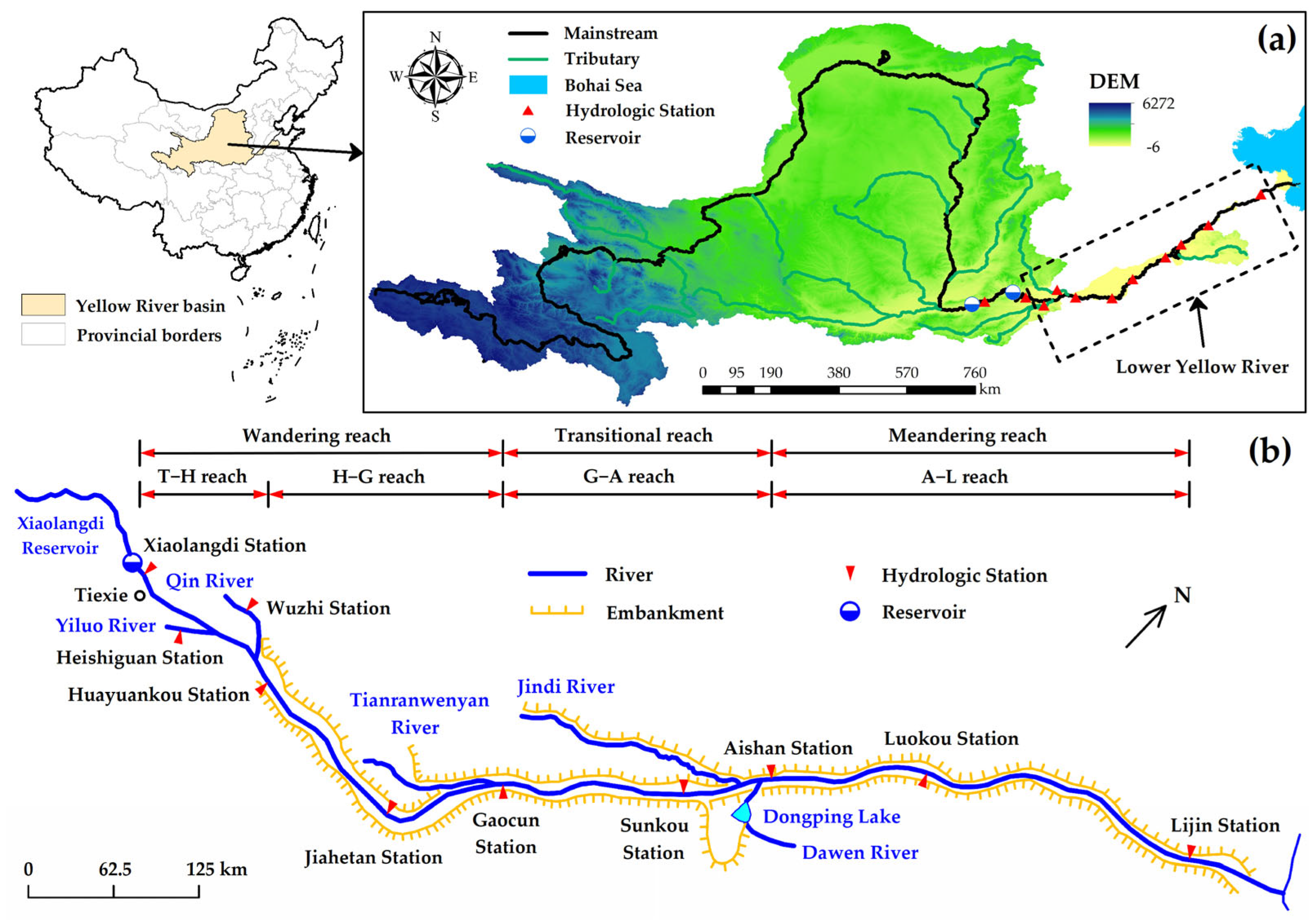
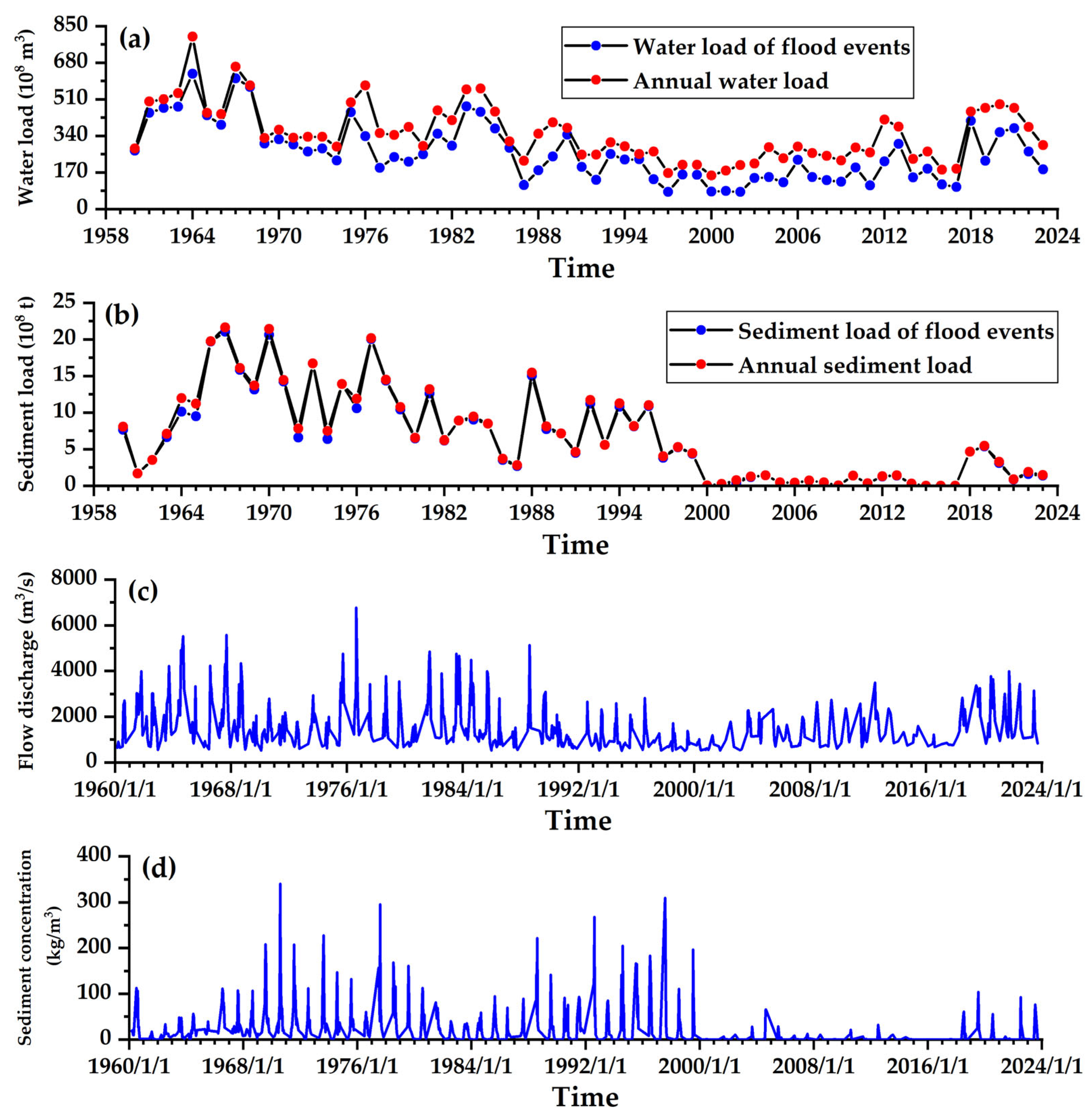
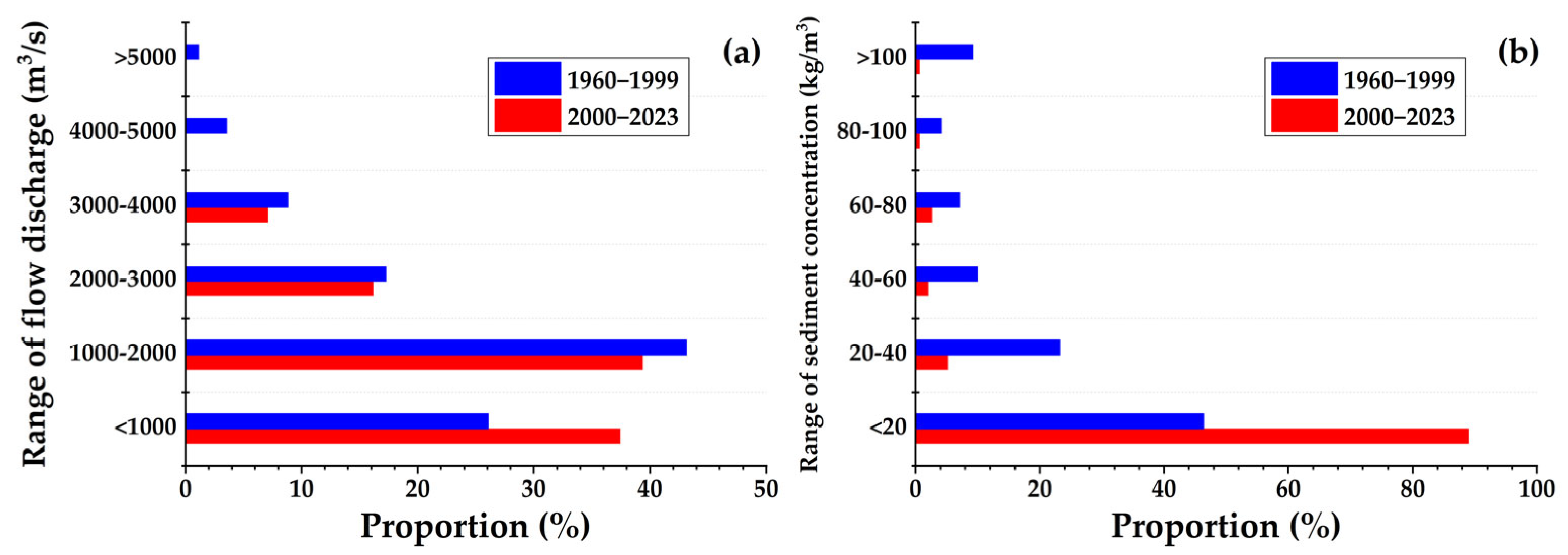
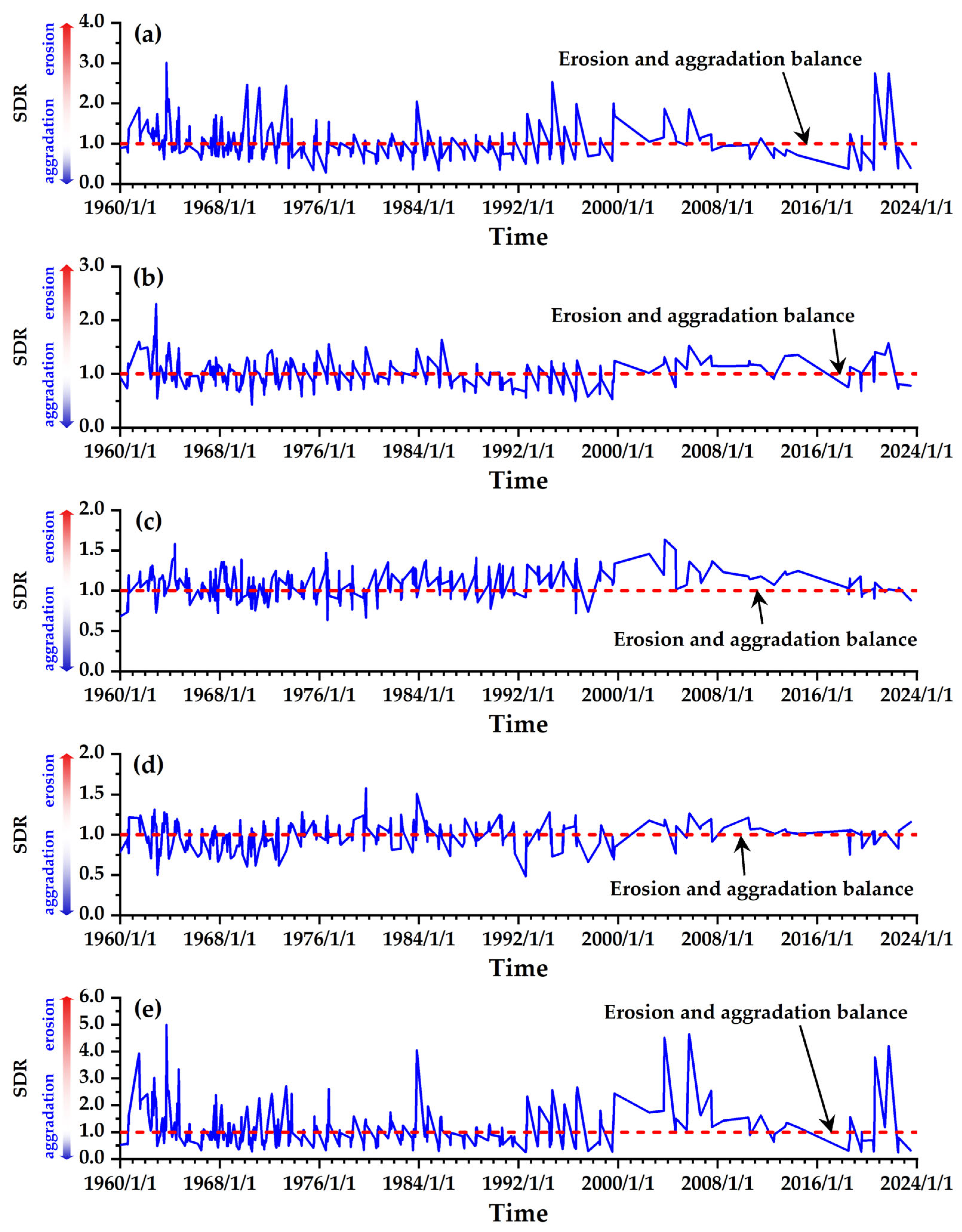

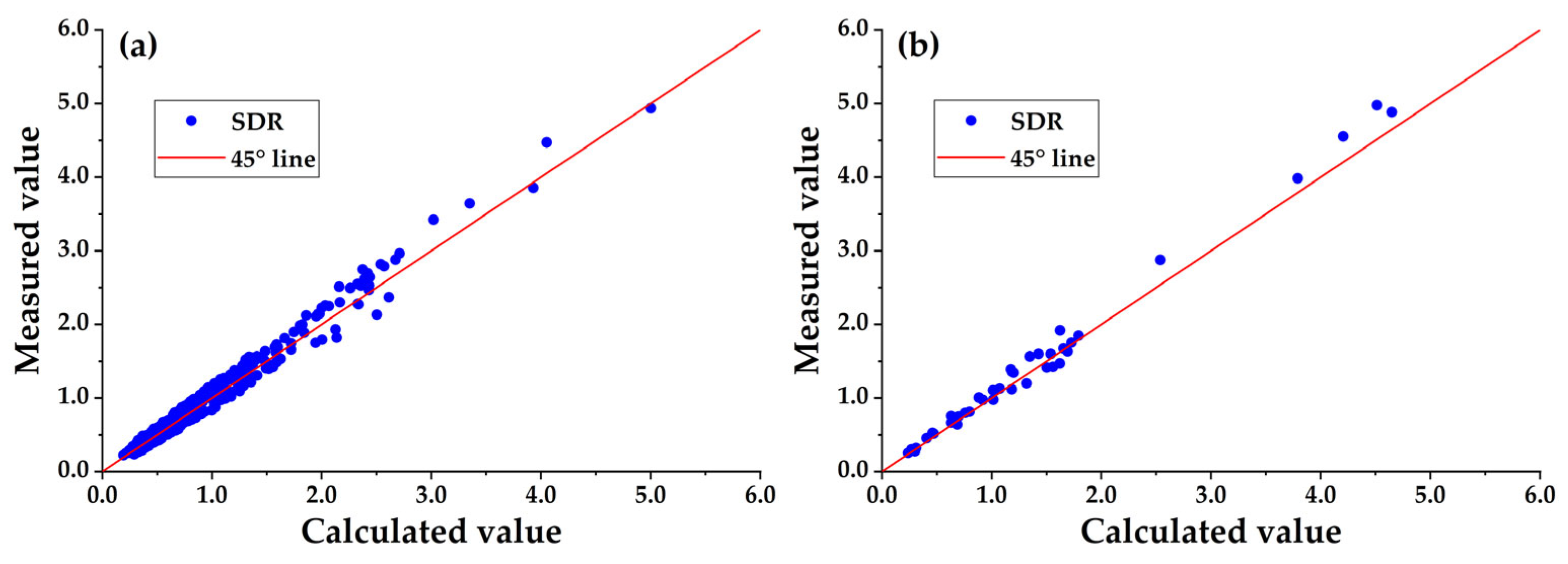
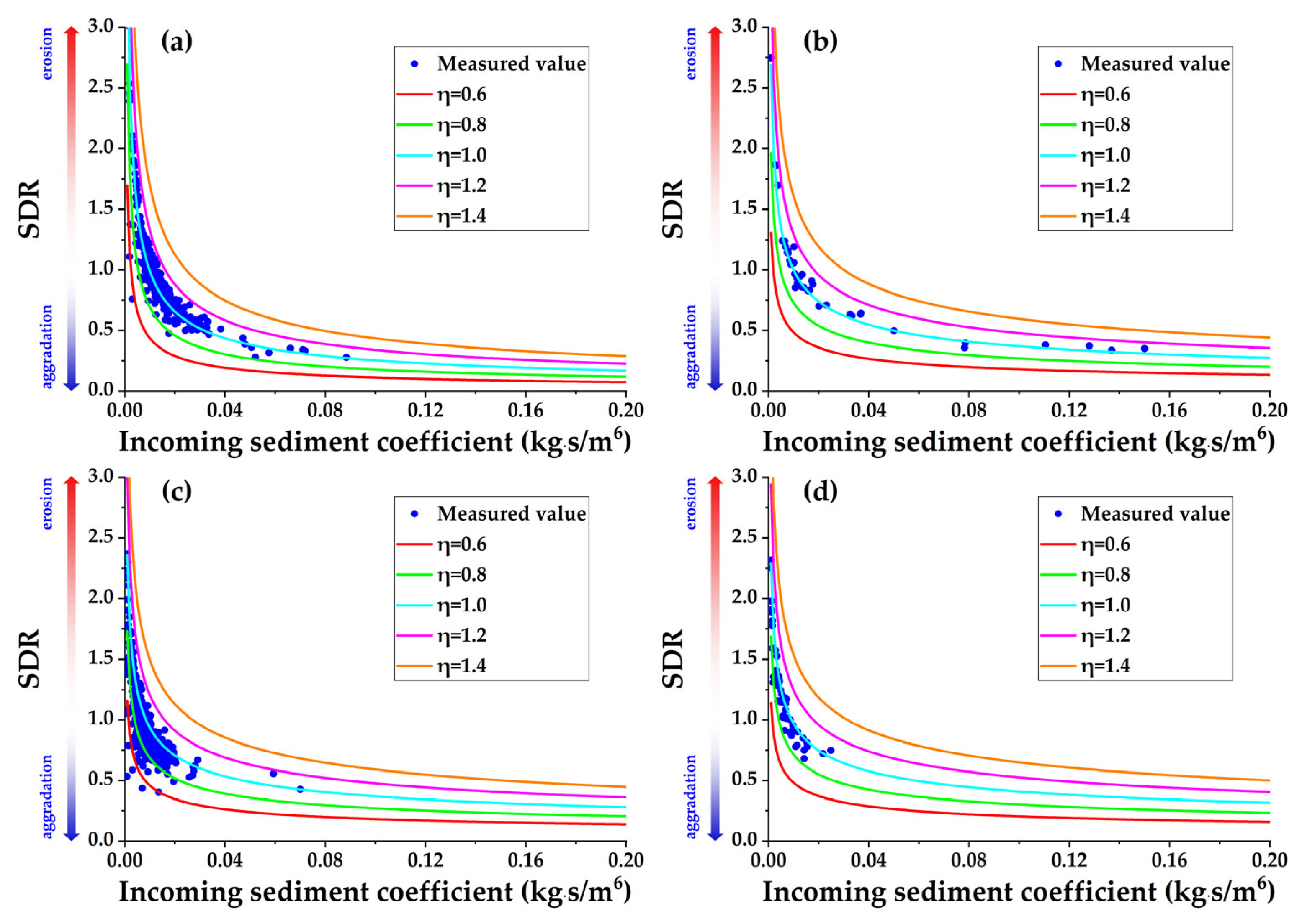
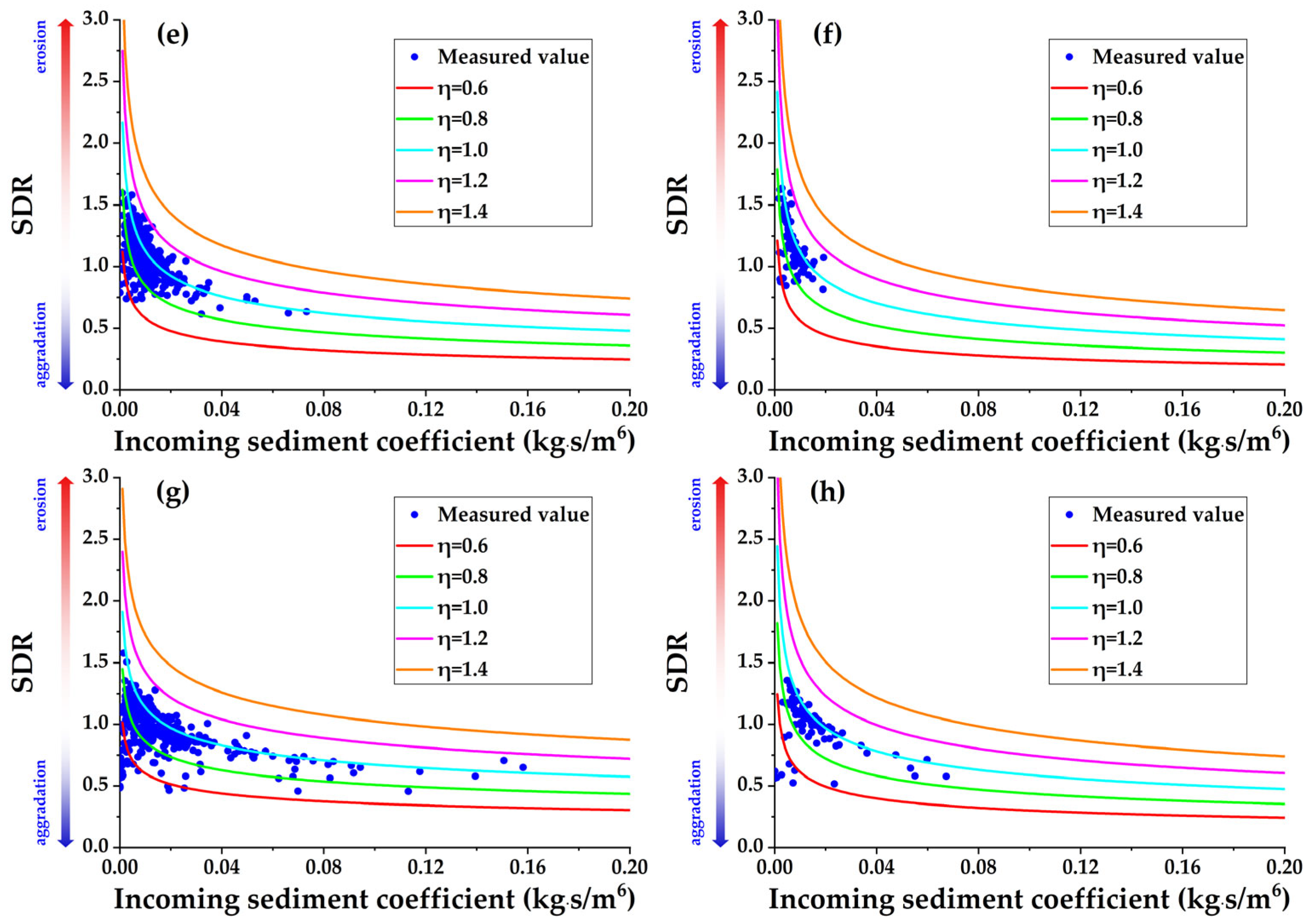


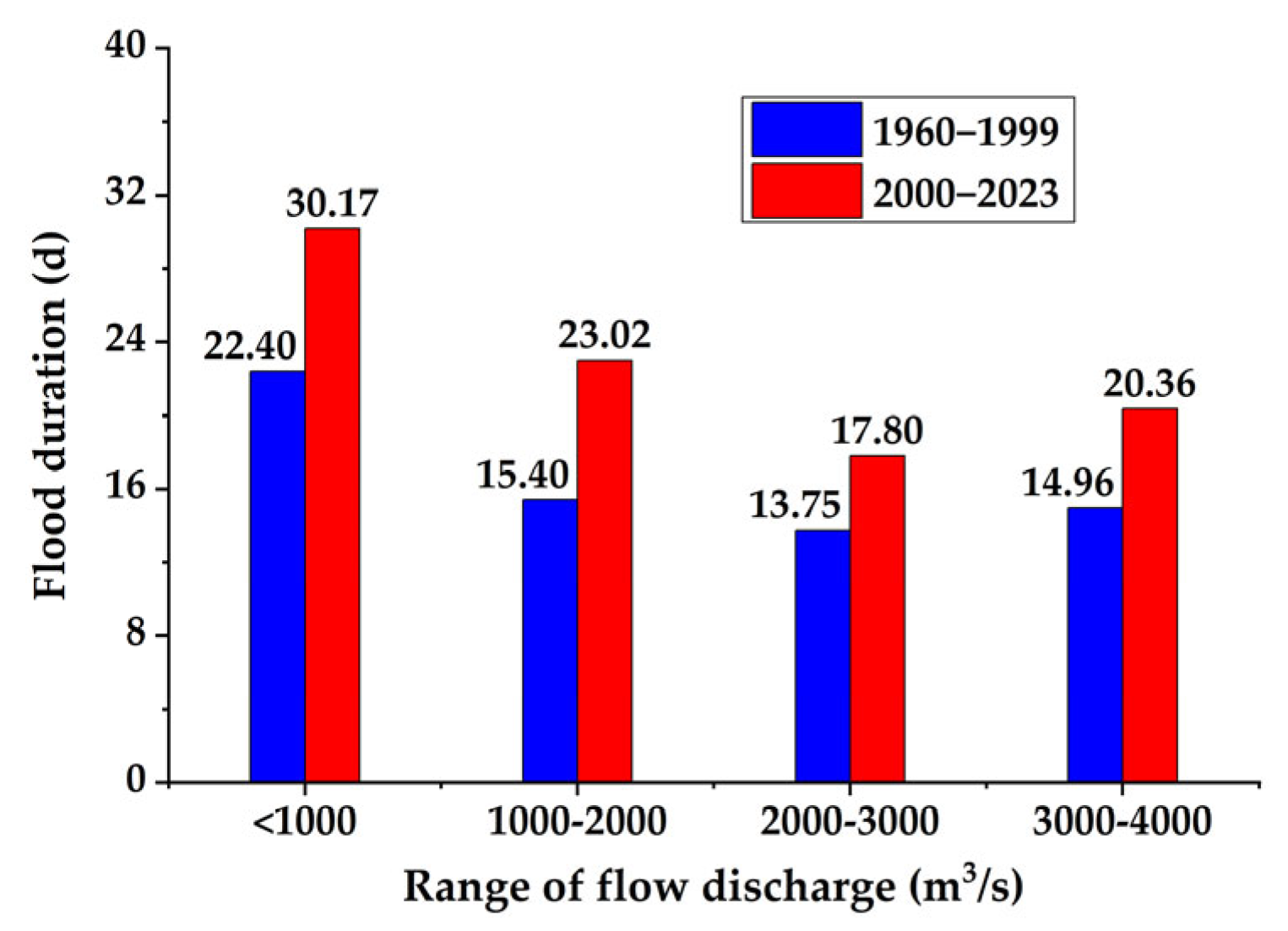

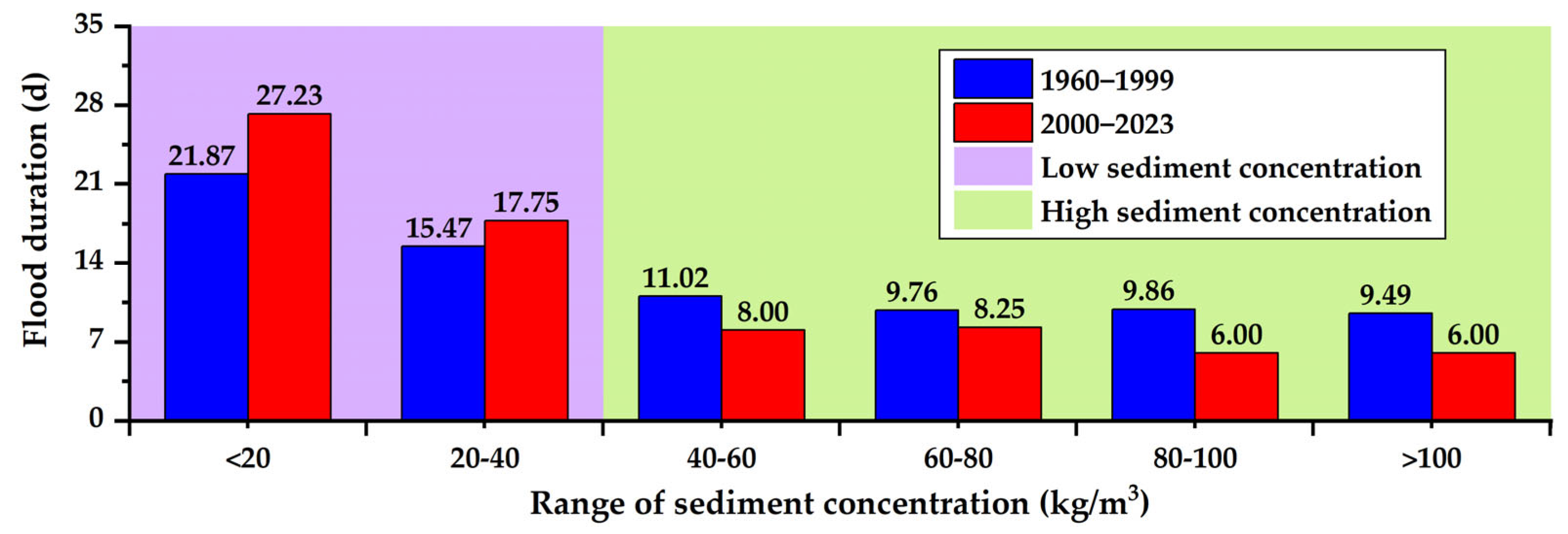
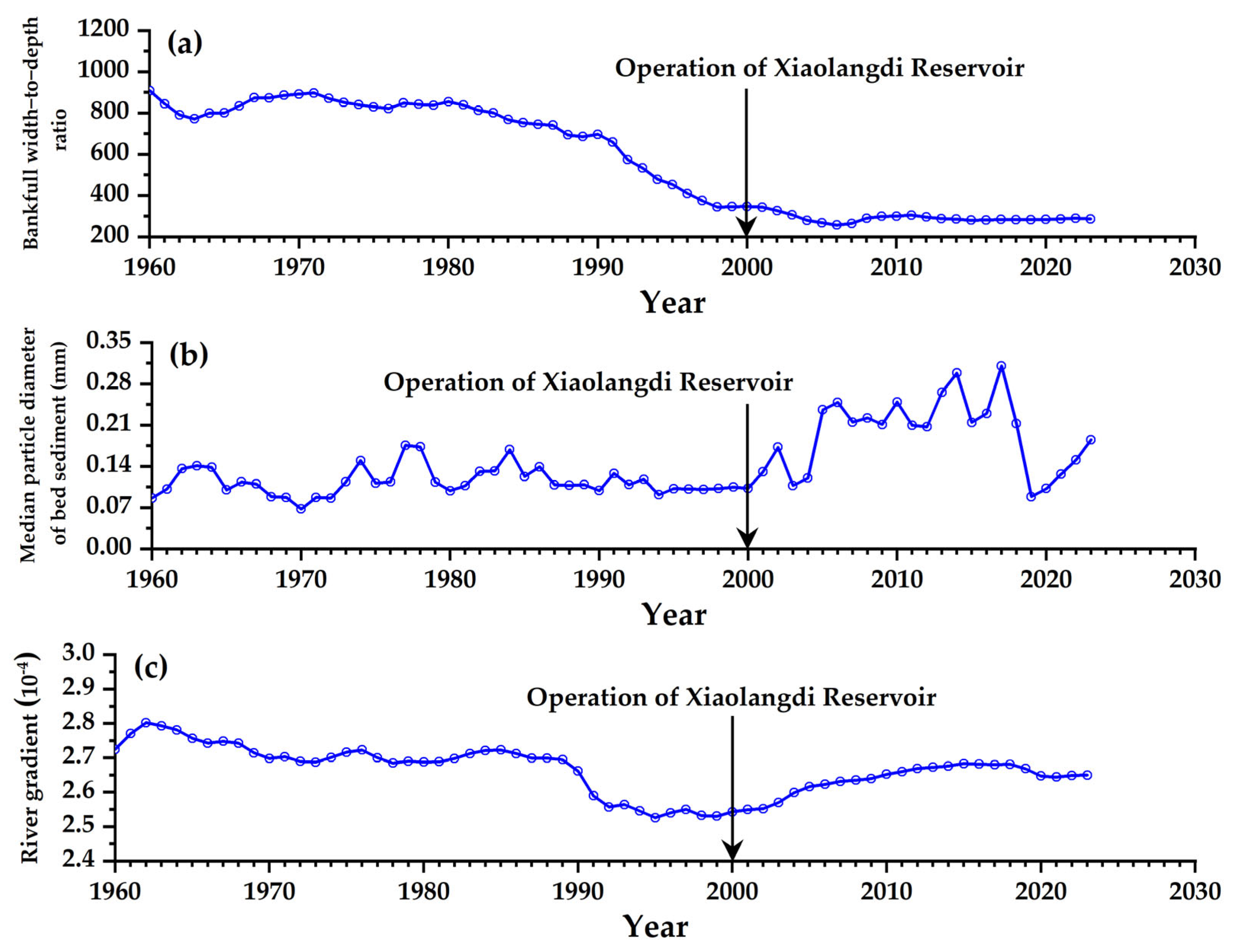
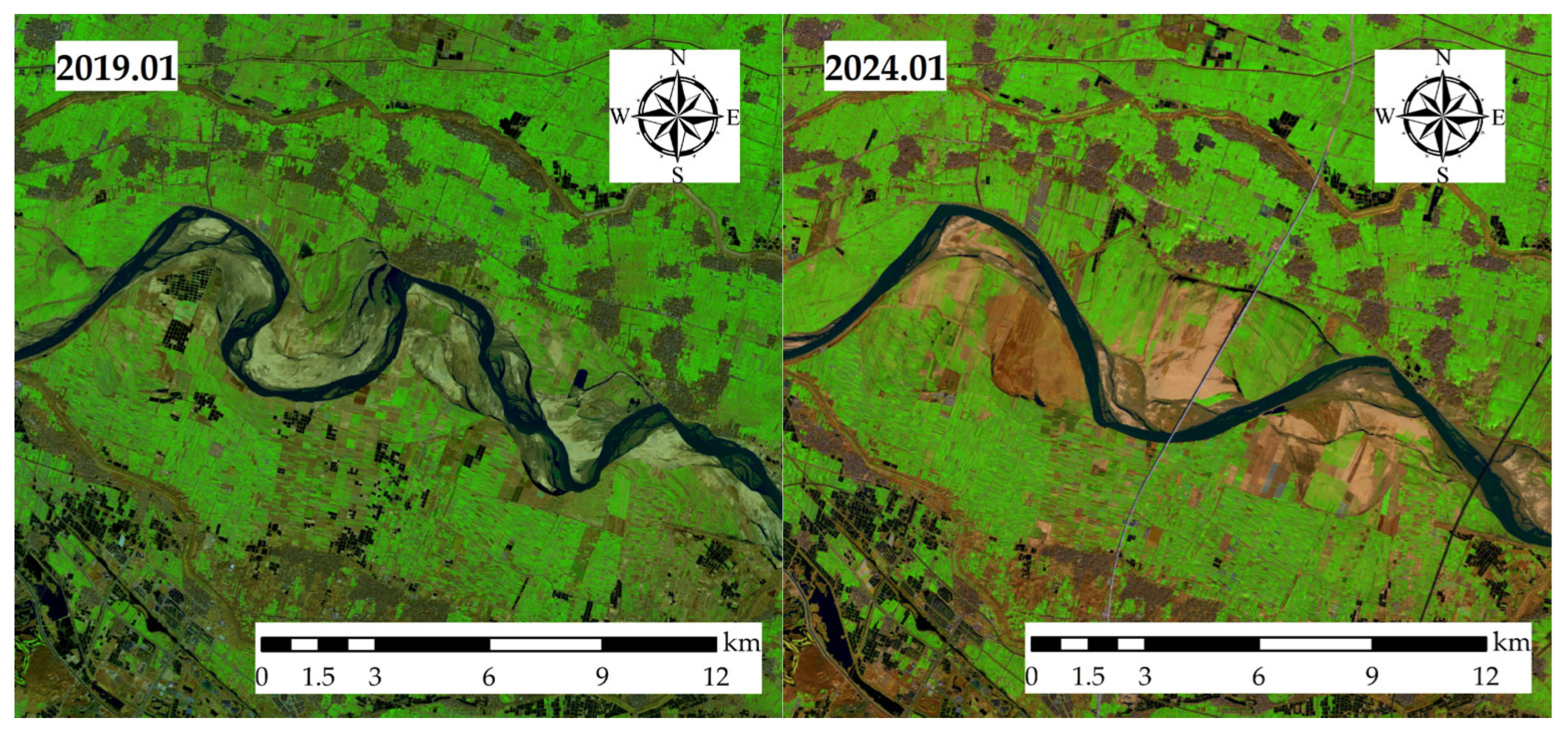
| Typical Period | Water–Sediment Conditions | Different Reaches | ||||
|---|---|---|---|---|---|---|
| Tiexie- Huayuankou | Huayuankou- Gaocun | Gaocun- Aishan | Aishan- Lijin | Tiexie- Lijin | ||
| 1960~1999 | Average flow discharge | 0.042 | 0.179 * | 0.415 ** | 0.566 ** | 0.131 ** |
| Average sediment concentration | −0.423 ** | −0.481 ** | −0.323 ** | −0.079 ** | −0.373 ** | |
| Incoming sediment coefficient | −0.427 ** | −0.578 ** | −0.632 ** | −0.522 ** | −0.394 ** | |
| Water load variation coefficient | 0.066 | 0.321 ** | 0.663 ** | 0.884 ** | 0.243 ** | |
| 2000~2023 | Average flow discharge | 0.024 | 0.162 * | 0.401 ** | 0.558 ** | 0.121 ** |
| Average sediment concentration | −0.432 ** | −0.488 ** | −0.346 ** | −0.102 ** | −0.379 ** | |
| Incoming sediment coefficient | −0.434 ** | −0.591 ** | −0.638 ** | −0.543 ** | −0.397 ** | |
| Water load variation coefficient | 0.074 | 0.344 ** | 0.612 ** | 0.823 ** | 0.284 ** | |
| Typical Period | Reach | Theoretical Formulation Parameter | R2 | ||
|---|---|---|---|---|---|
| K | α | β − 1 | |||
| 1960~1999 | Tiexie−Huayuankou | 0.065 | 1.604 | −0.591 | 0.814 |
| Huayuankou−Gaocun | 0.146 | 1.395 | −0.403 | 0.833 | |
| Gaocun−Aishan | 0.303 | 1.296 | −0.285 | 0.802 | |
| Aishan−Lijin | 0.399 | 1.244 | −0.227 | 0.836 | |
| Tiexie−Lijin | 0.067 | 1.628 | −0.643 | 0.786 | |
| 2000~2023 | Tiexie−Huayuankou | 0.137 | 1.417 | −0.431 | 0.813 |
| Huayuankou−Gaocun | 0.173 | 1.369 | −0.374 | 0.826 | |
| Gaocun−Aishan | 0.239 | 1.351 | −0.335 | 0.809 | |
| Aishan−Lijin | 0.289 | 1.317 | −0.309 | 0.867 | |
| Tiexie−Lijin | 0.118 | 1.525 | −0.513 | 0.831 | |
| Reach | Typical Period | |
|---|---|---|
| 1960~1999 | 2000~2023 | |
| Tiexie-Huayuankou | 2.013 | 1.986 |
| Huayuankou-Gaocun | 1.992 | 1.995 |
| Gaocun-Aishan | 2.011 | 2.016 |
| Aishan-Lijin | 2.017 | 2.008 |
| Tiexie-Lijin | 1.985 | 2.012 |
Disclaimer/Publisher’s Note: The statements, opinions and data contained in all publications are solely those of the individual author(s) and contributor(s) and not of MDPI and/or the editor(s). MDPI and/or the editor(s) disclaim responsibility for any injury to people or property resulting from any ideas, methods, instructions or products referred to in the content. |
© 2025 by the authors. Licensee MDPI, Basel, Switzerland. This article is an open access article distributed under the terms and conditions of the Creative Commons Attribution (CC BY) license (https://creativecommons.org/licenses/by/4.0/).
Share and Cite
Zhang, X.; Zhang, M.; Zhang, C.; Sun, Z.; Zhao, B. Impact of the Xiaolangdi Reservoir Operation on Water–Sediment Transport and Aquatic Organisms in the Lower Yellow River During Flood Events. Sustainability 2025, 17, 8136. https://doi.org/10.3390/su17188136
Zhang X, Zhang M, Zhang C, Sun Z, Zhao B. Impact of the Xiaolangdi Reservoir Operation on Water–Sediment Transport and Aquatic Organisms in the Lower Yellow River During Flood Events. Sustainability. 2025; 17(18):8136. https://doi.org/10.3390/su17188136
Chicago/Turabian StyleZhang, Xueqin, Min Zhang, Chunjin Zhang, Zanying Sun, and Binhua Zhao. 2025. "Impact of the Xiaolangdi Reservoir Operation on Water–Sediment Transport and Aquatic Organisms in the Lower Yellow River During Flood Events" Sustainability 17, no. 18: 8136. https://doi.org/10.3390/su17188136
APA StyleZhang, X., Zhang, M., Zhang, C., Sun, Z., & Zhao, B. (2025). Impact of the Xiaolangdi Reservoir Operation on Water–Sediment Transport and Aquatic Organisms in the Lower Yellow River During Flood Events. Sustainability, 17(18), 8136. https://doi.org/10.3390/su17188136





